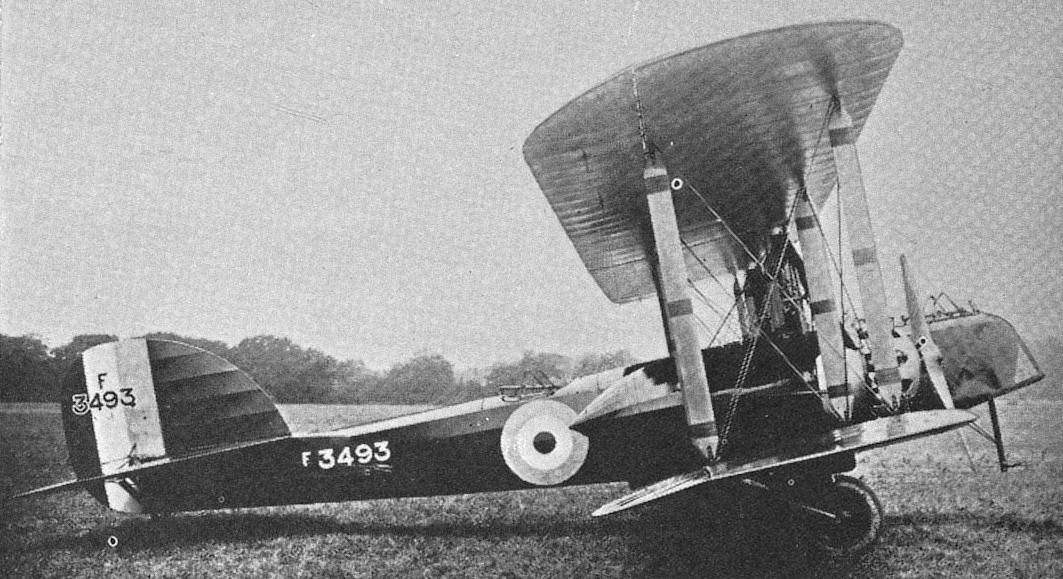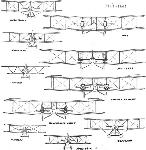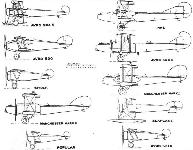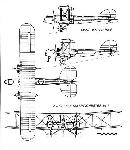A.Jackson Avro Aircraft since 1908 (Putnam)
Avro 533 Manchester
The Manchester of 1918, final variation on the Pike/Avro 529 theme, was a three seat, twin engined bomber or photo reconnaissance fighter designed to Air Ministry requirements round two of the new 320 h.p. A.B.C. Dragonfly I seven cylinder radial engines. Unlike its forebears the Manchester was constructed entirely at Hamble and its deeper, more shapely fuselage giving improved crew accommodation was but one of many refinements, others including a graceful (almost de Havilland-shaped) rudder, and ailerons balanced by means of 'park bench' auxiliary aerofoils.
Erection of the first Manchester was completed by October 1918 after which it was dismantled for covering, during which the opportunity was taken to fit two 300 h.p. Siddeley Puma high compression, watercooled engines. This was to prevent interruption of flight tests by the non-delivery of the Dragonfly engines which had run into a number of teething troubles. The Pumas arrived at Hamble in November, and thus powered, the aircraft was known as the Avro 533A Manchester Mk. II. First flights took place early in December 1918 and the Mk. II aircraft F3492 consequently had an earlier serial than the Mk. I which followed. On December 20 F3492 went to No. 186 Development Squadron, Gosport, where it remained until at least January 9, 1919 before proceeding to Martlesham in the following March. Official trials lasted until September 1919 when F3492 returned to Hamble to be fitted with Napier Lions, a project which did not materialise.
Delivery of the Dragonfly engines in December 1919 enabled the second airframe F3493 to be completed as the Manchester Mk. I. After prolonged manufacturer's tests it was flown from Hamble to Martlesham for official trials in October 1919, the journey via Winchester, Basingstoke, London and Chelmsford occupying 90 minutes.
Apart from the engines and the revised nacelle shape of the Mk. I which decreased the effective area of the lower wing by 4 sq. ft., the two marks of Manchester differed only in their tail units. Both had balanced rudders but all tail surface areas were greater in the Mk. I which had taller vertical surfaces and an unbalanced elevator. That of the Mk. II was horn balanced.
The performance of both marks was quite remarkable on comparatively low power and despite their size could be looped and spun, but the need for a bomber of this type disappeared when the war ended. A third airframe, intended as the Manchester III with two 400 h.p. Liberty engines, was completed but the engines were never fitted. The jigs were then dismantled and A. V. Roe's war effort was at an end.
SPECIFICATION AND DATA
Manufacturers: A. V. Roe and Co. Ltd., Hamble Aerodrome, near Southampton, Hants.
Power Plants:
(Mk. I) Two 320 h.p. A.B.C. Dragonfly I
(Mk. II) Two 300 h.p. Siddeley Puma high compression
(Mk. III) Two 400 h.p. Liberty 12
Dimensions:
Span 60 ft. 0 in. Length 37 ft. 0 in. Height 12 ft. 6 in.
Wing area (Mk. I) 813 sq. ft. (Mk. II) 817 sq. ft.
Weights:
(Mk. I) Tare weight 4,887 lb. All-up weight 7,390 lb.
(Mk. II) Tare weight 4,574 lb. All-up weight 7,158 lb.
Performance:
(Mk. I) Maximum speed 112 m.p.h.
Climb to 10,000 ft. 14 min. 20 sec.
Ceiling 19,000 ft. Endurance 5 | hours
(Mk. II) Maximum speed 119 m.p.h.
Climb to 10,000 ft. 16 min. 30 sec.
Ceiling 17,000 ft. Endurance 3$ hours
Production:
F3492 (Manchester Mk. II); F3493 (Manchester Mk. I);
F3494 (Manchester Mk. III) airframe only
F.Manson British Bomber Since 1914 (Putnam)
Avro Type 533 Manchester
The culmination of A V Roe's dogged persistence in the development of a twin-engine medium bomber, and one that maintained the general configuration of the Type 523A and 529, the Type 533 might well have gained substantial production orders had it not been for the unfortunate choice of powerplant, the 320hp ABC Dragonfly I nine-cylinder air-cooled radial engine.
The Dragonfly had been designed by Granville Bradshaw in 1917, who claimed that it would develop 340hp at a weight of just over 600 lb, and, with simplicity of production said to be an important attribute, was ordered in huge numbers in 1918 (amounting to no fewer then 11,050 engines from 13 manufacturers). Production got underway, and it was planned to have completed over 4,000 engines by mid-1919.
Production engines were soon giving trouble. Apart from being overweight, they failed to deliver the promised power and vibrated violently in flight, leading to component breakage and total failure after very few running hours. New pistons and cylinder heads were designed but, early in 1919, it was clear that the entire engine required redesign, the troubles being caused by dynamic imbalance and high-frequency torsional vibration, a phenomenon not understood in 1918.
Three prototypes of the Type 533 Manchester (F3492-F3494) were ordered from A V Roe on 15 May 1918, the Dragonfly I engine being scheduled to be fitted in all three. However, by the time the first airframe was taking shape, the company was warned that, owing to the problems then emerging, deliveries of the engine were being temporarily suspended. In order to proceed with flight trials as quickly as possible, 300hp high-compression Siddeley Puma engines were substituted, this aircraft being termed the Type 533A Manchester II, and first flown early in December 1918.
The new bomber, capable of carrying a bomb load of 880 lb, incorporated a number of improvements over the Type 529, including a shorter, deeper fuselage, enlarged tail surfaces and bench-type aileron balances; these comprised small aerofoils located above and forward of the ailerons, so that depressing the aileron increased the incidence angle of the small aerofoils, thereby providing a balancing moment. The Puma engines, being slightly lighter than the Dragonfly, bestowed an excellent performance, though slightly inferior to that expected with the latter, and the Manchester was found to be pleasant to handle, and possessed of outstanding manoeuvrability. In due course the aircraft was looped, and proved to be entirely manageable in a spin.
The Dragonfly engines were delivered during December 1918 and were fitted in the second Manchester, F3493, which now became the Mark I, as being the version intended for production. F3493 was first flown on 27 May 1919, and was delivered to Martlesham Heath in April for performance trials, exactly on schedule. In these trials it confirmed the expectations provided by the Puma-powered prototype, which had undergone evaluation the previous month, returning a speed of 112 mph at 10,000 ft while carrying full fuel and half the maximum bomb load. It was generally considered to handle better than the other twin-engine aircraft then being prepared for competition to decide on a replacement for the D.H. 10 Amiens in service.
However, continuing trouble with the Dragonfly engine caused Roy Chadwick to consider the Liberty 12 engine as a possible alternative, and there is little doubt but that this powerplant would have resulted in a first-class medium bomber. In the event a pair of modified Dragonfly IA engines became available and these were fitted in the third Manchester, F3494 (the Mark III). This was flown in about September or October 1919, and delivered to Martlesham Heath on 21 October, remaining there until September the following year.
In the meantime, in the absence of adequate Service funding, the Air Ministry had decided to abandon a replacement for the D.H. 10, preferring to let it remain in service until, by natural wastage, the aircraft became extinct. With the grounding of the Dragonfly in September 1920, all flying of the Manchester also ended.
Type: Twin-engine, three-crew, three-bay biplane bomber.
Air Ministry Specifications: RAF Types IV, VI and VIII.
Manufacturer: A V Roe & Co Ltd, Hamble, Hampshire
Powerplant: Mark I. Two 320hp ABC Dragonfly I nine-cylinder, air-cooled, radial engines driving two-blade propellers. Mark II. Two 300hp Siddeley Puma high-compression in-line engines. Mark III. Scheduled for two 400hp Liberty 12 in-line engines, but flown with Dragonfly IA radials, and/or Lion in-line engines.
Dimensions: Span, 60ft 0in; length, 37ft 0in; height, 12ft 6in; wing area, 813 sq ft (Mark I), 817 sq ft (Mark II).
Weights: Mark I. Tare, 4,887 lb; all-up, 7,390 lb. Mark II. Tare, 4,574 lb; all-up. 7,158 lb.
Performance: Mark I. Max speed, 130 mph at sea level, 112 mph at 10,000ft; climb to 10,000ft, 14 min 20 sec; service ceiling, 19,000ft; endurance, 5 1/4 hr. Mark II. Max speed, 125 mph at sea level; climb to 10,000ft, 16 min 30 sec; service ceiling, 17,000ft; endurance, 33/4 hr.
Armament: Two 0.303in Lewis machine guns with Scarff rings on nose and midships gunners' positions. Bomb load of up to 880 lb.
Prototypes: Three, F3492-F3494. First flight by F3492 in December 1918 at Hamble; F3493 first flown on 27 May 1919, and F3494 in about October 1919. No production.
P.Lewis British Bomber since 1914 (Putnam)
The disappointing behaviour of the A.B.C. Dragonfly affected A. V. Roe as two 320 h.p. Dragonfly I engines had been selected as the units around which the Avro 533 Manchester fast day bomber was designed in 1918. Basically, the three-seat Manchester - which was built at the Hamble, Hants., factory - was a revision of the 523 Pike and the 529 biplanes. In general aspect, the new machine was cleaner aerodynamically than its lineal predecessors and was slightly smaller both in span and in length.
The Manchester was to suffer initially in precisely the same way as the other prototypes scheduled to use the Dragonfly; in its own case a pair of water-cooled 300 h.p. high-compression Siddeley Pumas in deep nacelles were chosen as substitutes. These enabled F3492, the 533A Manchester Mk. II, to take to the air early in December, 1918, following the completion of its airframe a few weeks before in October.
A year later, in December, 1919, the Dragonfly engines arrived at Hamble and were installed in F3493, the machine being allotted its original designation of 533 Manchester Mk. I. Revised tail surfaces accompanied the fitting of the Mk. I’s Dragonfly power plants. F3494, the Manchester Mk. III, was completed as far as the airframe but was not fitted with its intended pair of 400 h.p. Liberty 12 engines. The Manchester’s bomb load was to be 880 lb.; defensive armament comprised two Lewis guns - one in the nose and the other amidships. The Manchester was generally comparable with the Bourges, but its greater size and weight gave it a relatively lower general performance than the Boulton and Paul product. Even so, the Avro machine was still very manoeuvrable and capable of aerobatics.
J.Bruce British Aeroplanes 1914-1918 (Putnam)
Avro 533, the Manchester
THE ultimate war-time expression of the Avro twin-engined bomber concept was given in the excellent Manchester design of 1918. Its descent from the Pike and the Avro 529 was clearly discernible, but the Manchester showed several structural and aerodynamic improvements over its predecessors. The fuselage was shorter and deeper, and provided better accommodation for the crew of three; the arrangement of the interplane struts was simplified; and the tail surfaces were of more pleasing outline. The ailerons were balanced in an unusual way. Instead of the more normal horn balance, each aileron had, mounted above and parallel to it, a small auxiliary aerofoil. Thus, any depression of an aileron increased the angle of attack of the small aerofoil and produced a balancing force; the opposite effect was obtained on a raised aileron. Construction of the Manchester was undertaken at the Avro company’s Hamble works.
The Manchester was first designed early in 1918, at a time when great hopes were entertained for the A.B.C. Dragonfly radial engine, which was then going into production. The Manchester was therefore designed to have two Dragonflies, but as the aircraft neared completion it became evident that no engines were going to be available in time. To permit flight trials of the airframe, the first Manchester was modified to have Siddeley Puma engines and was designated the Avro 533A Manchester Mark II.
The engines were two high-compression Pumas which delivered 300 h.p. each, and with them the Manchester II was tested in December, 1918. Dragonfly engines ultimately became available, and a true Manchester Mk. I was completed with two Dragonflies. This chain of circumstances accounts for the fact that the Mk. II had the earlier serial number F.3492, whilst the Mk. I was F.3493.� The tail-unit of the Manchester Mk. I differed from that of the Mk. II. The area of all tail surfaces was appreciably increased in the Mk. I; the fin and rudder were taller; and the Mk. I had plain elevators whereas those of the Mk. II had inset horn balances. Both machines had balanced rudders. A third version was projected with twin Liberty engines but was never built. The third Manchester airframe was, however, completed.
The Manchester appeared too late to go into production, but the performance of both Marks compared favourably with that of the more powerful D.H.10A, and bore testimony to the excellence of the design.
SPECIFICATION
Manufacturers: A. V. Roe & Co., Ltd., Hamble.
Power: Manchester Mk. I: two 320 h.p. A.B.C. Dragonfly I. Manchester Mk. II: two 300 h.p. Siddeley Puma (high compression). Manchester Mk. Ill: two 400 h.p. Liberty (projected).
Dimensions: Span: 60 ft. Length: 37 ft. Height: 12 ft 6 in. Chord: 7 ft 6 in. Gap: 7 ft 3 in. Stagger: nil. Dihedral: 2° 30'. Incidence: 40. Span of tail: 13 ft. Airscrew diameter: 2-9 metres.
Areas: Wings: upper 430 sq ft; lower (Mk. I) 383 sq ft, (Mk. II) 387 sq ft: total (Mk. I) 813 sq ft, (Mk. II) 817 sq ft. Ailerons: each 31 sq ft, total 124 sq ft. Tailplane: (Mk. I) 69 sq ft, (Mk. II) 50 sq ft. Elevators: (Mk. I) 38 sq ft, (Mk. II) 35 sq ft. Fin: (Mk. I) 16 sq ft, (Mk. II) 12 sq ft. Rudder: (Mk. I) 18 sq ft, (Mk. II) 16 sq ft.
Weights {lb) and Performance:
Manchester Mk. I Manchester Mk. II
No. of Trial Report M.266 -
Date of Trial Report October, 1919 -
Weight empty 4,887 4’574
Military load 433 1,074
Crew 540 540
Fuel and oil 1,530 970
Weight loaded 7,390 7,158
Maximum speed (m.p.h.) at
ground level - 125
6,500 ft 114-5 -
10,000 ft 112 119
15,000 ft 103-5 112-5
m. s. m. s.
Climb to
5,000 ft - - 6 30
6,500 ft 8 20 - -
10,000 ft 14 20 16 30
15,000 ft 28 00 32 00
17,000 ft - - 43 00
Service ceiling (feet) 19,000 17,000
Endurance at 10,000 ft (hours) 5 3/4 3 3/4
Tankage: Petrol (gallons) 183 116
Armament: Bomb load: 880 lb. One Lewis machine-gun on ScarfF ring-mounting on bow cockpit, one Lewis gun on similar mounting on rear cockpit aft of wings.
Production: Three prototypes were built at Hamble.
Serial Numbers: F.3492-F.3494 (F.3492 was the Manchester Mk. II, F.3493 was the Mk. I).
H.King Armament of British Aircraft (Putnam)
Manchester. The Manchester twin-engined bomber of 1918 was comparable with the Boulton & Paul Bourges. Bombs up to some 880 lb in weight were stowed internally and were aimed and released from the nose position, where there was a hinged window, as on the Bourges, and a Scarff ring-mounting. There was a similar defensive gun installation in the dorsal position aft of the wings. Twin guns were apparently intended for both mountings.
Журнал Flight
Flight, March 20, 1919.
"MILESTONES"
The Avro Machines
The Avro "Manchesters." December, 1918.
The success which was attained with the earlier model twin-engined machines, from the point of view of performance, encouraged the Avro firm to get out a design for a modern machine of this type, to be an improvement upon previous models chiefly as regards its engines, which were to be of the A.B.C. Dragonfly type, which was by then - we are now speaking of the earlier part of 1918 - beginning to go into production, and which had an extraordinary power/weight ratio. With such engines available a very good performance was anticipated, and the drawings for the "Manchester" Mark I were got out. However, it was found that after all the engines could not be obtained, and so a slightly modified form of machine was designed - the "Manchester" Mark II - which was fitted with two Siddeley "Puma" engines, instead of the two Dragonfly engines originally contemplated. The " Manchester" II was put through its tests in December, 1918, and gave, as indicated in the tables, very good results in the way of speed and climb. As shown in the illustrations, the two types of "Manchesters" are very similar, except, of course, as regards the engine housings. As in the previous Avro twins, the pilot occupies the middle seat, with one gunner in front and one in the rear. A feature which will scarcely escape the notice of readers is the unusual arrangement whereby the ailerons are balanced. Instead of the ordinary small forward projection at the outer end of the aileron, now so frequently seen on large machines, the "Manchesters" have a small auxiliary plane mounted on two short struts from the main aileron, and placed slightly ahead of it, so as to produce a balancing effect. The advantages expected from this arrangement are probably structural rather than aerodynamic, since by doing it in this fashion the twist of the aileron leading edge, caused by the usual balance placed at the extreme end of the aileron, is avoided. We believe that in some recent German machines a similar arrangement has been tried, but differing in that the small auxiliary plane is below the main plane instead of above it as in the Avros.
More recently we believe the Dragonfly engines have been obtained, and the "Manchester" Mark I tried with them as originally intended, with good results. We understand that the "Manchester" II is being fitted with a cabin for passenger and mail carrying, and probably, therefore, more will be heard of this machine later on.










